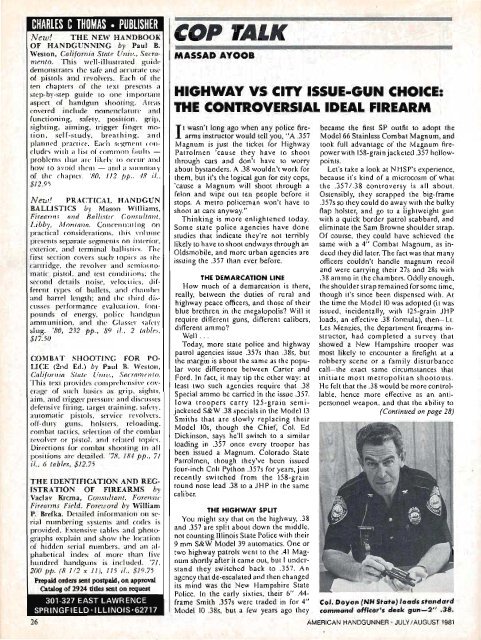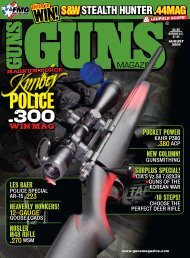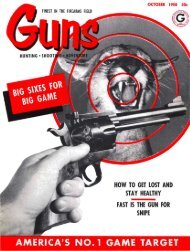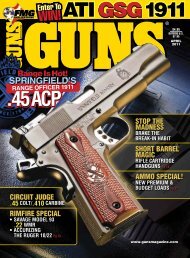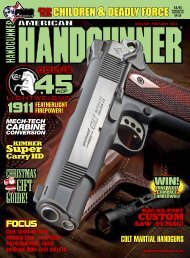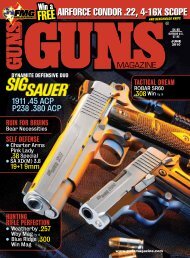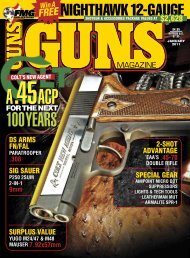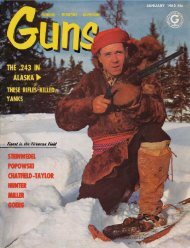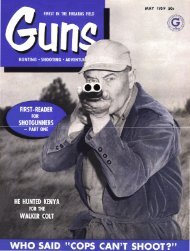American Handgunner Jul/Aug 1981 - Jeffersonian
American Handgunner Jul/Aug 1981 - Jeffersonian
American Handgunner Jul/Aug 1981 - Jeffersonian
You also want an ePaper? Increase the reach of your titles
YUMPU automatically turns print PDFs into web optimized ePapers that Google loves.
New! THE NEW HANDBOOK<br />
OF HANDGUNNING by Paul B.<br />
Weston, California State Univ., Sacramento.<br />
This well-illustrated guide<br />
demonstrates the safe and accurate usc<br />
of pistols and revolvers. Each of the<br />
ten chapters of the text presents a<br />
step-by-step guide to one important<br />
aspect of handgun shooting. Areas<br />
covered inelude nomenclature and<br />
functioning, safety, position, grip,<br />
sighting, aiming, trigger finger motion,<br />
self-study, breathing, and<br />
planned practice. Each segment coneludes<br />
with a list of common faults <br />
problems that are likely to occur and<br />
how to avoid them - and a summary<br />
of the chapter. '80, 112 pp., 48 il.,<br />
$12.95<br />
New! PRACTICAL HANDGUN<br />
BALLISTICS by Mason Williams,<br />
Firearms and Ballistic Consultant,<br />
Libby, Montana. Concentrating on<br />
practical considerations, this volume<br />
presents separate segments on interior,<br />
exterior, and terminal ballistics. The<br />
first section covers such topics as the<br />
cartridge, the revolver and semiautomatic<br />
pistol, and test conditions; the<br />
second details noise, velocities, different<br />
types of bullets, and chamber<br />
and barrel length; and the third discusses<br />
performance evaluation, footpounds<br />
of energy, police handgun<br />
ammunition, and the Glasser safely<br />
slug. '80, 232 pp., 89 il., 2 tables,<br />
$17.50<br />
COMBAT SHOOTING FOR PO<br />
LICE (2nd Ed.) by Paul B. Weston,<br />
California State Unill., SaC1"n111(>nto.<br />
This text provides comprehensive CO\'<br />
erage of such basics as grip, sights,<br />
aim, and trigger pressure and discusses<br />
defensive firing, target training, safety,<br />
automatic pistols, service revolvers,<br />
off-duty guns, holsters, reloading,<br />
combat tactics, selection of the combat<br />
revolver or pistol, and related topics.<br />
Directions for combat shooting in all<br />
positions are detailed. '78, 184 pp., 71<br />
il., 6 tables, $12.75<br />
THE IDENTIFICATION AND REG<br />
ISTRATION OF FIREARMS by<br />
.Vaclav Krcma, Consultant, Forensic<br />
Firearms Field. Foreword by William<br />
P. Brefka. Detailed information on serial<br />
numbering systems and codes is<br />
provided. Extensive tables and photographs<br />
t'lxplain and show the location<br />
of hidden serial numbers, and an alphabetical<br />
index of more than five<br />
hundred handguns is included. '71,<br />
200 pp. (81/2 x 11), 115 il., $19.75<br />
Prepaid orders sent postpaid, on approval<br />
Catalog of 2924 tides sent on request<br />
301-327 EAST LAWRENCE<br />
SPRINGFIELD 'ILLINOIS '62717<br />
26<br />
COP TALK<br />
MASSAD AYOOB<br />
HIGHWAY VS CITY ISSUE-GUN CHOICE:<br />
THE CONTROVERSIAL IDEAL FIREARM<br />
I<br />
t wasn't long ago when any police firearms<br />
instructor would tell you, "A .3.57<br />
Magnum is just the ticket for Highway<br />
Patrolmen 'cause they have to shoot<br />
through cars and don't have to worry<br />
about bystanders. A .38 wouldn't work for<br />
them, but it's the logical gun for city cops,<br />
'cause a Magnum will shoot through a<br />
felon and wipe out ten people before it<br />
stops. A metro policeman won't have to<br />
shoot at cars anyway."<br />
Thinking is more enlightened today.<br />
Some state police agencies have done<br />
studies that indicate they're not terribly<br />
likely to have to shoot endways through an<br />
Oldsmobile, and more urban agencies are<br />
issuing the .357 than ever before.<br />
THE DEMARCATION LINE<br />
How much of a demarcation is there,<br />
really, between the duties of rural and<br />
highway peace officers, and those of their<br />
blue brethren in the megalopolis? Will it<br />
require different guns, different calibers,<br />
different ammo?<br />
Well ...<br />
Today, more state police and highway<br />
patrol agencies issue .357s than .38s, but<br />
the margin is about the same as the popular<br />
vote difference between Carter and<br />
Ford. In fact, it may tip the other way: at<br />
least two such agencies require that .38<br />
Special ammo be carried in the issue .357.<br />
Iowa troopers carry 125-grain semijacketed<br />
S&W .38 specials in the Model 13<br />
Smiths that are slowly replacing their<br />
Model lOs, though the Chief, Col. Ed<br />
Dickinson, says he'll switch to a similar<br />
loading in .357 once every trooper has<br />
been issued a Magnum. Colorado State<br />
Patrolmen, though they've been issued<br />
four-inch Colt Python .357s for years, just<br />
recently switched from the 158-grain<br />
round nose lead .38 to a JHP in the same<br />
caliber.<br />
became the first SP outfit to adopt the<br />
Model 66 Stainless Combat Magnum, and<br />
took full advantage of the Magnum firepower<br />
with 158-grainjacketed .357 hollowpoints.<br />
Let's take a look at NHSP's experience,<br />
because it's kind of a microcosm of what<br />
the .357/.38 controversy is all about.<br />
Ostensibly, they scrappeo the big-frame<br />
.357s so they could do away with the bulky<br />
flap holster, and go to a lightweight gun<br />
with a quick border patrol scabbard, and<br />
eliminate the Sam Browne shoulder strap.<br />
Of course, they could have achieved the<br />
same with a 4" Combat Magnum, as indeed<br />
they did later. The fact was that many<br />
officers couldn't handle magnum recoil<br />
and were carrying their 27s and 28s with<br />
.38 ammo in the chambers. Oddly enough,<br />
the shoulder strap remained for some time,<br />
though it's since been dispensed with. At<br />
the time the Model 10 was adopted (it was<br />
issued, incidentally, with 125-grain JHP<br />
loads, an effective .38 formula), then-Lt.<br />
Les Menzies, the department firearms instructor,<br />
had completed a survey that<br />
showed a New Hampshire trooper was<br />
most likely to encounter a firefight at a<br />
robbery scene or a family disturbance<br />
call-the exact same circumstances that<br />
initiate most metropolitan shootouts.<br />
He felt that the .38 would be more controllable,<br />
hence more effective as an antipersonnel<br />
weapon, and that the ability to<br />
(Continued on page 28)<br />
THE HIGHWAY SPLIT<br />
You might say that on the highway, .38<br />
and .357 are split about down the middle,<br />
not counting Illinois State Police with their<br />
9 mm S&W Model 39 automatics. One or<br />
two highway patrols went to the AI Magnum<br />
shortly after it came out, but I understand<br />
they switched back to .357. An .<br />
agency that de-escalated and then changed<br />
its mind was the New Hampshire State<br />
Police. In the early sixties, their 6" 044<br />
frame Smith .357s were traded in for 4" Col. Doyon (NH State) loads standard<br />
Model 10 .38s, but a few years ago they command officer's desk gun-2" .38.<br />
AMERICAN HANDGUNNER • JULY / AUGUST <strong>1981</strong>


